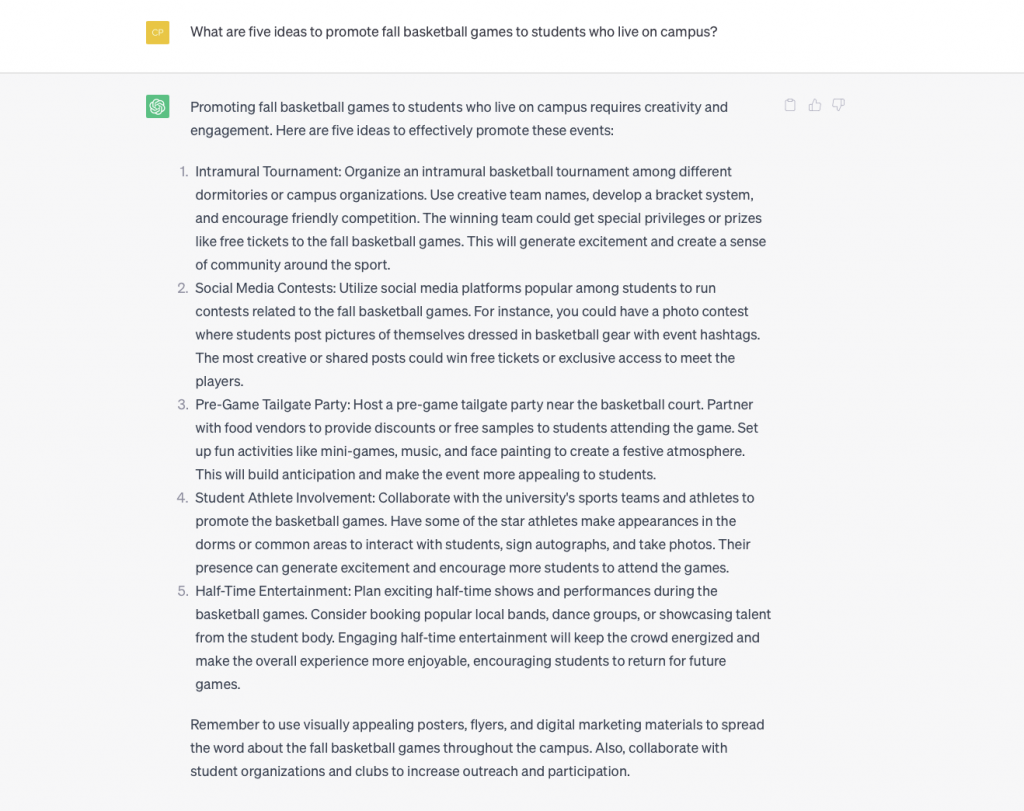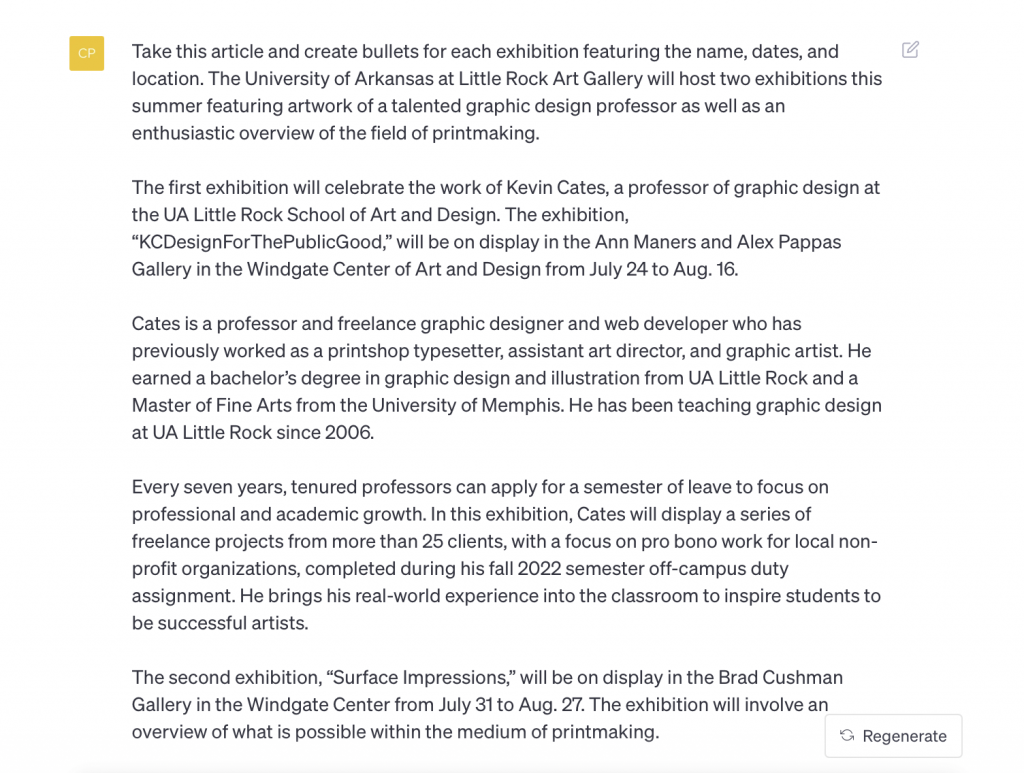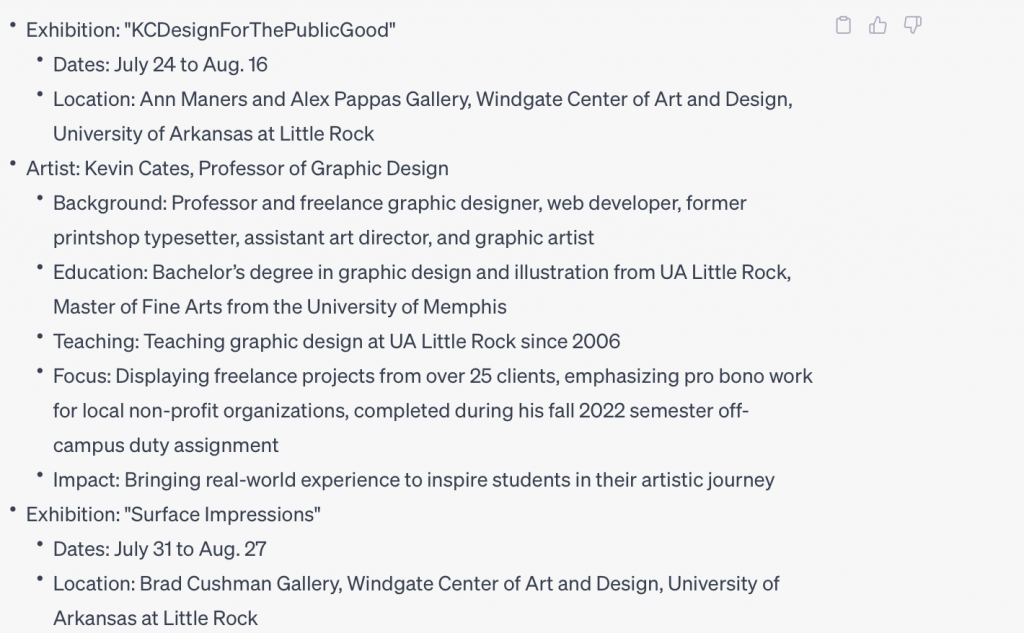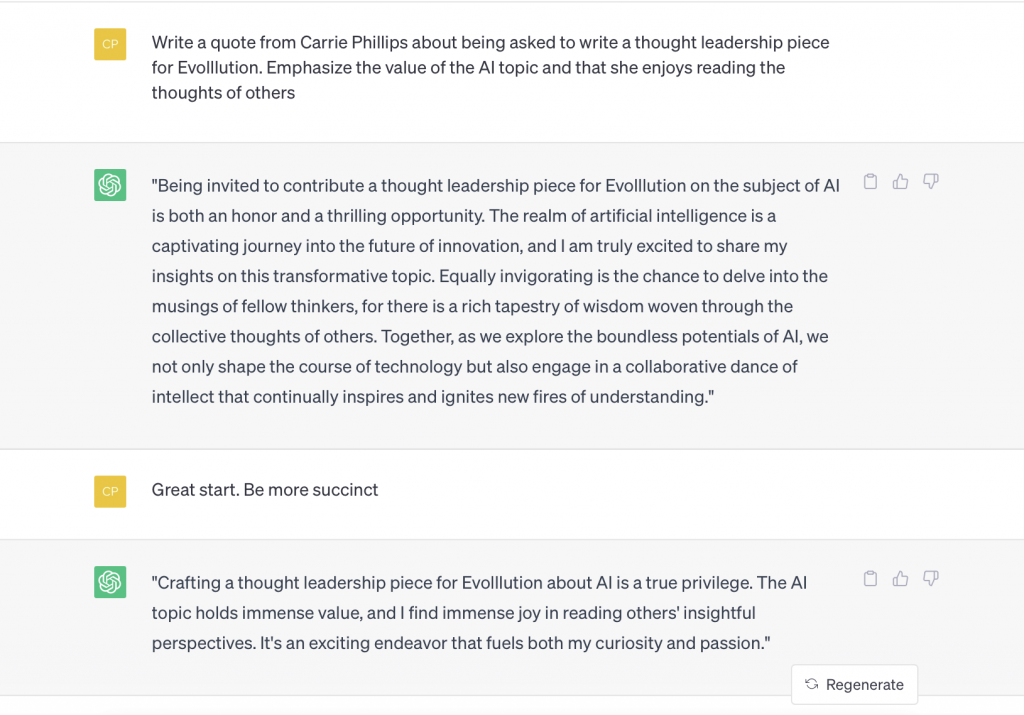Published on
It Starts with a Question: Use Cases for Working with AI

The marketing world changed November 30, 2022, when OpenAI launched its language-based chatbot, ChatGPT. For the first time, users could provide prompts for messages in a question-and-answer format and steer results by providing feedback, which became the catalyst for a wave of artificial intelligence tools.
Over the past eight months, marketers have grappled with the ethics of the tools, possible ways to use them and how these tools will change the course of our work. I’ve seen it discussed on campus message boards, among professors and with staff, all of whom have strong feelings about whether it should be used in marketing and communications work.
In playing with the tool and talking to others, I believe artificial intelligence can help us work smarter, and there are a few use cases I’ve found beneficial. I hope these examples can provide some context of how our profession can use artificial intelligence to better our work.
Brainstorming Awareness Ideas
This is the part of the tool I’ve used most recently. It will not work for a cut-and-paste solution, but it can get a team’s creativity flowing. In a recent brainstorming session, our team used ChatGPT to start the conversation by asking it to help us brainstorm a few marketing ideas for a particular situation. We used its basic (and somewhat generic ideas) to build upon and develop a customized strategy that aligned with the university and its goals. However, ChatGPT serves as a good starting point. It covered the basics immediately, allowing us to use our time to delve into more nuanced discussions. Similarly, I could also see it serving as a pulse check to make sure marketing teams haven’t forgotten something obvious in their brainstorming.

Brainstorming Messaging Ideas
I have also used it to help brainstorm phrasing that can work with campus taglines. For example, if your tagline is “Discover You,” asking ChatGPT to write 2 to 3 sentences of marketing copy can help you develop different ways to incorporate this phrasing into messaging. For me, it brought in some different approaches I wouldn’t have necessarily thought of due to my personal frame of reference. Using the tool in this way expanded my arsenal of options to pull from when I need branded messaging. It’s important to note that this is not something to be used on its own because the copy is generic. It only works if I’m willing to add in the additional context I have about the brand.
Editing Copy
This is probably the area where I’ve used the tool the most. Several of my print pieces were too long and filled with too much jargon. Using ChatGPT, I’ve been able to drop the original copy into the tool and tell it what to emphasize and how much to trim. In multiple instances, it’s achieved this task with little to no edits needed.
I also needed to make several blocks of copy more readable, so I asked ChatGPT to convert about two paragraphs into bullet points. The tool was able to do this task in a matter of seconds, when it would normally take me at least 30 minutes. While I had to make some light edits, it did provide me with significant time savings.


Writing Basic Communications
I often get requests to write communications for emails and postcards that inform the campus or community of something happening. It could be back-to-school information, an upcoming event or an opportunity to give back. Often, these messages come to the office in the form of basic details that haven’t been made into a branded message. ChatGPT does a great job of taking the details and developing a branded message that can go into an email or printed piece as needed. While these messages aren’t hard for marketing experts to come up with, they do take time. Using artificial intelligence allows marketing and communications teams to use their bandwidth to focus on other work.
Writing Quotes
Writers are often told, “Just make me sound smart” or “Build a quote for me to review.” Trying to come up with unique quotes for others can be difficult, especially if it’s something you’re regularly asked to do. Several writers I know have used ChatGPT for help crafting quotes for leadership. The quotes are submitted for the leader to review and finesse, but they provide a starting point to the conversation and alleviate the pressure on the writer to continually figure out what to say.

Crafting Job Descriptions
While I have not used this application, a colleague of mine was working on a job description and engaged Chat GPT to help. The description needed some additional detail, and the person used the tool to help develop additional bullet points to include in the job responsibilities. The tool also reviewed the completed job description and provided recommendations of different terminology that better aligned with industry-specific jargon.
Word of Advice
If you’re trying out the tool, here are a few tips to maximize your effort.
1. Ask multiple times
If you’re brainstorming, ask your question a couple of different ways. This reformulation will help you generate several options to merge or build on to craft something that’s exactly what you’re looking for.
2. Be specific
The more context and detail you provide, the better your outcome. I’ll include things like background about why I need the message, what angle to emphasize, what format I’m looking for, my desired length and how I intend to use the message. These specifications get me much closer to my desired outcome than if I speak in generalities.
3. Provide feedback in the same thread
Despite giving great context, sometimes the tool misses. If it didn’t give you what you wanted, use the same thread to provide feedback and ask the tool to try again. It’s pretty good at incorporating feedback to get closer on the second try. If the tool isn’t delivering after the third try, I suggest starting a new thread and beginning again.
4. Start a new thread for each request
Threads are active for a month in the free model, so can see your history and reuse threads for similar needs. This function has been incredibly helpful, as I’ve found myself pulling from copy multiple times for slightly different uses, and individual threads make it easier to find.
What’s Next
It’s hard to believe these tools have only been available for a few months. I find myself asking what the next year will look like. While I don’t have all the answers, here are a few ways I could see this tool having an impact on the work we do over time.
Student search
It seems likely that students will use ChatGPT or other AI tools to do college research. How can universities ensure their content is updated? I’m assuming the tool does a crawl of our websites, which is one more reason to be updating them. Are there other ways we should be thinking about adjusting copy to resonate with this kind of tool?
Personalization
Many APIs are in development, so it seems likely that we’ll be able to trigger much more personalized communication emails and messaging campaigns. I don’t quite know how that will work, but I could see some complex campaigns being developed using the tool to make the work a much lighter burden on our teams.
Linking
Right now, all the tools do is share information. However, the tool will likely do more soon. Can it collect and provide RFIs? Can it help students apply for admission or financial aid? I’m not sure, but it would be smart to watch our corporate colleagues to see how they use the tool in this way and develop similar strategies for students and donors.
Author Perspective: Administrator



